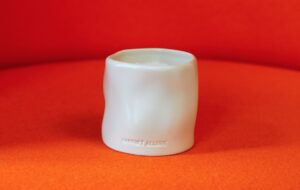
Words Sam Jacob
The stars seem to blister like burning film as they open into pink flowers. The night sky segues into the blossom on a cherry tree, and we follow the falling petals and see a group of characters hopping and waving in a bandstand surrounded by woods.
This is the psychedelic opening sequence of In the Night Garden, a BBC television show for the under-fours. The scene apparently represents the shift into dream state, and it’s the most beautiful and surprising cosmic screen since Dave Bowman’s journey through 2001: A Space Odyssey’s slit-scan landscapes. In both, we go “through” the sky into an alternate reality.
This particular alternate reality comes from Anne Wood and Andy Davenport of Ragdoll, co-creators of the Teletubbies and bona fide auteurs of kids’ TV in an era of terrible animation, pre-teen plotlines and ham-fisted edutainment.
We’re not here for complex plot though, but the show’s beautiful design. Children’s TV demands much more from production design than adult shows. A whole autonomous world needs to be constructed. Narrative is constrained – in this case by lack of language. The characters say little more than variations on their name over and over again, their inarticulacy mixed with excitement like hyperactive Beckett protagonists. Without plot, the burden falls on other elements, often those considered secondary in “grown-up” programmes: vision, sound, movement, landscape and so on. The programme’s design constructs experience without language, which is not so far removed from design in the real world.
In the Night Garden’s characters are descendants of the entire gene pool of children’s TV. Igglepiggle is a plush blue toy with a wonky grin and a red blanket. His co-star is Upsy Daisy, a toy-girl whose hair wiggles like small fingers when she’s excited. There are the Tombliboos with bottom-heavy, baby-esque anatomy; Makka Pakka, a loner who lives in what seems to be a neolithic barrow and sports cairn-like hair and ears; the Pontipines, a family of wooden puppets who live in a tiny doll’s house at the base of a huge tree trunk; and the Haahoos, five enormous inflatable forms who call to each other and sleep in a big pillowy pile. The characters’ anatomies range from “primitive”, carved-wood, solid forms to sci-fi, inflatable, empty ones, shifting from puppet to costume to prop, in scale from tiny to huge.
They inhabit a landscape both giant and miniature, with large trees, giant-sized daisies and pastel-coloured puffballs. Like the Teletubbies, the landscape is a surreal reworking of nature. Perhaps this is the last residue of the English Landscape tradition – Capability Brown made over by video-game designer Shigeru Miyamoto. Here, on the branches of real trees, a computer-colourised bird choir sings a chorus of synthetic sounds. There are references to the Magic Roundabout in the bandstand, to Camberwick Green in its mechanics, to Thunderbird 2 in the Pinky Ponk airship’s green livery, to Trumpton in the
echoey, naive folk music. That a programme for the under-fours should be soaked in nostalgia is of course odd. But perhaps nostalgia is not really about time or personal history but a cultural product. In the Night Garden is a faultless example of manufactured nostalgia, whose hope is to construct a space outside parents’ terrible fear for their children’s future by evoking their own past.
The texture of the image is made just as rich by combining live action, rickety stop-frame and gradient perfect CGI, and a soundtrack of organic sci-fi squelching that might have arrived fresh from the Radiophonic Workshop. The programme’s construction is perhaps the most sophisticated on British TV. And the effect is fantastic.

















